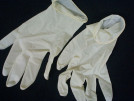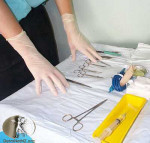Background
Over 90% of natural rubber comes from the latex, or milky sap, of the rubber tree, Hevea brasiliensis.
Latex is used in a large number of products including adhesives, foam, carpet backing and in a number of dipped products including surgical gloves, household gloves, catheters, condoms, and balloons. Natural latex rubber is also found in toys, erasers, sports equipment, clothing, elastic bands, and many medical and dental devices.
What causes latex allergy?
For reasons not yet clearly understood, some individuals can become allergic to certain constituents of the latex molecule. Once allergic, sensitivity remains lifelong.
The onset of recommendations for universal precautions resulted in increased use of latex gloves; to meet the increased demand, manufacturing processes may have changed resulting in a more highly allergic product.
Who is at risk of latex allergy?
Anyone who is exposed to latex may become sensitised; fortunately, the majority of individuals do not. However, certain populations are more at risk:
- Rubber-industry workers
- Healthcare workers (from wearing rubber gloves)
- Individuals with congenital urinary anomalies (from use of catheters and other latex devices) such as children with spina bifida.
- Individuals with a history of sensitivity to certain foods such as banana, avocado, chestnut, tomato, peach or kiwifruit
- Individuals who have undergone multiple medical/surgical procedures
- Individuals with a history of non-medication related anaphylactic reactions during anaesthesia.
What are the reactions to latex
The common reactions of latex-sensitive individuals exposed to latex are contact urticaria, dermatitis and asthma.
Contact urticaria usually presents with itching and swelling of the skin at the site of contact with latex, for example, hands from wearing gloves, genitals from contact with condoms, and so on. The symptoms usually start within 5–15 minutes after coming into contact with the latex article, although it can be delayed for several hours. Symptoms can continue for a variable period, from several hours to days after the latex contact has ceased.
Contact dermatitis from latex may take several days to appear. It presents with an itchy, scaly rash, although there may be small blisters if the reaction is acute. The rash will usually last several days to weeks but if exposure to latex continues, the rash will last longer. Contact dermatitis is not generally caused by sensitivity to latex protein but rather to the chemicals used in the manufacture of the latex product, including antioxidants and rubber accelerators thiuram, carbamates, and mercaptobenzothiazole.
Immediate-type hypersensitivity requires a previous sensitisation and is the most potentially dangerous reaction to latex. Clinical presentations vary but may include contact urticaria, coryza, conjunctivitis, stinging or burning, asthma, and, with mucosal or parenteral exposure, anaphylaxis. A common cause for the asthmatic reaction is powdered gloves. The starch powder picks up the latex proteins and when the gloves are removed the powders can then be inhaled or come into contact with the skin on the face where it can cause an allergic reaction.
Exposure methods
Contact through the skin, mucous membranes, parenteral, intravenous and inhalation.
How to diagnose latex allergy?
In most cases, a diagnosis of latex allergy can be made from an accurate history and clinical examination. There are a number of skin tests which can confirm latex sensitivity, including patch tests (for allergic contact dermatitis type reactions), skin prick test (for contact urticaria type reactions) and radioallergosorbent assay blood test (RAST), which is not as accurate as the skin tests.
Guidelines for health care workers
Help prevent latex sensitivity
- Use appropriate work practices to reduce the chance of reactions to latex.
- Wear nitrile or polyurethane gloves where practical. If wearing latex gloves, choose non-powdered options.
- When wearing latex gloves, use only approved barrier cream. After removing latex gloves, wash hands thoroughly and dry thoroughly.
- Practice good housekeeping: frequently clean areas and equipment contaminated with latex-containing dust.
- Learn to recognise the symptoms of latex allergy: skin rash; urticaria; flushing; itching; nasal, eye or sinus symptoms; asthma; and (rarely) shock.
- Care should be exercised when removing latex gloves to reduce the risk of exposure of latex allergens to self and/or colleagues.
Latex allergy in the health care worker
- Avoid contact with latex gloves and products. Commonly used latex medical products include rubber gloves; elastic bandages; adhesive tape; urinary catheters; electrode pads; wound drains; stomach and intestinal tubes; urinary collection devices; protective sheets; enema tubing and tips; dental cofferdams; rubber pads; and fluid circulating warming blankets. Equipment containing latex includes haemodialysis and anaesthesia equipment; rubber masks; electrode pads; head straps; rubber tourniquets; rubber nasal-pharyngeal airways; rubber oral-pharyngeal airways; teeth protectors; bite blocks; blood pressure cuffs; rubber breathing circuits; reservoir breathing bags; rubber ventilator hoses and bellows; rubber endotracheal tubes; latex cuffs on plastic tracheal tubes; latex injection ports on intravenous tubing; and certain epidural catheter injection adaptors.
- Avoid areas where powder may be inhaled from latex gloves worn by other workers.
- Tell your employer and health providers (physicians, nurses, dentists, etc.) that you have a latex allergy.
- Wear a medical alert bracelet.
- Consult with your doctor to determine whether you should carry emergency adrenaline (epinephrine) kit in case of accidental exposure to latex and/or in the event of anaphylactic shock (adrenaline immediately counteracts the shock).
Patients with latex sensitivity
The following guidelines are summarised FDA advice to health professionals to ensure a patient's latex allergy is not overlooked:
- Include questions about latex sensitivity when taking a patient's health history; ask patients whether they have ever experienced itching, rash or wheezing after wearing latex gloves or inflating a toy balloon. Spina bifida patients are at higher risk for acquiring latex allergy, as are others who have undergone numerous medical procedures. As well, patients with sensitivity to certain foods (chestnuts, kiwifruit, bananas, avocado, peaches, figs, passion fruit) should be considered at high risk for latex allergy.
- Those patients who report signs of latex allergy should have the allergy recorded in the clinical notes.
- Ensure patients are informed when they have had a suspected latex-related allergic reaction while under the professional's care, and recommend a latex allergy test to those individuals.
- A latex-safe environment should be offered to patients with latex allergy:
- no-one in the area should wear powdered natural rubber gloves
- only non-latex gloves should be used to directly examine the patient
- do not inject or withdraw fluid through rubber ports or intravenous lines
- all-natural rubber latex products that routinely directly or indirectly come into contact with mucosa, non-intact skin, and internal bodily spaces (eg, catheters, endotracheal tubes) should be removed or made latex-safe (eg, by covering: blood pressure cuffs used over clothing, stethoscope tubing covered with stockinette)
- products made of dry-moulded rubber (eg, wheelchair tyres, tool handles) do not need to be removed from the area but if direct contact with such objects is routine, precautions should be taken to minimise direct exposure by covering the object or body part exposed (ie, having the patient wear nonlatex gloves while wheeling self in a wheelchair)
- hospital dietary services should have latex-safe meals that lack food known to cross-react with antibodies to natural rubber latex (eg, avocado, banana, potato, tomato, papaya, chestnut or kiwifruit)
- if a latex-safe operating room is not always available, patients should be scheduled as the first procedure of the day so that latex-allergens can not build up in the environment.
- For patients with an identified latex allergy, add an alert in clinical notes, and recommend medical alert bracelet. Staff will need to have latex-free products available. It is recommended that each ward/department consider which of their patients are likely to be high risk and develop an emergency kit of latex-free products for use (acknowledging that there may be other patients not identified as high risk, who may develop a latex allergy). The equipment required will vary and will need to be identified by the clinical area.

